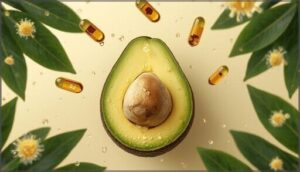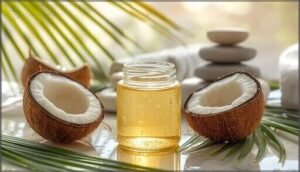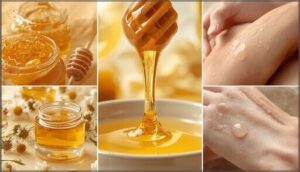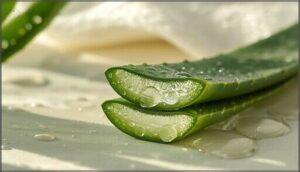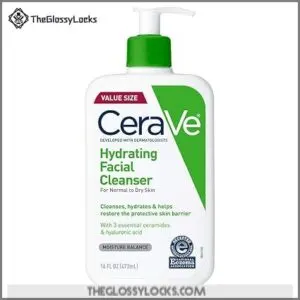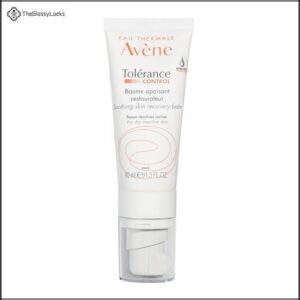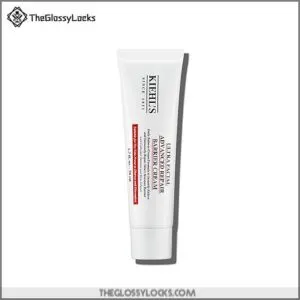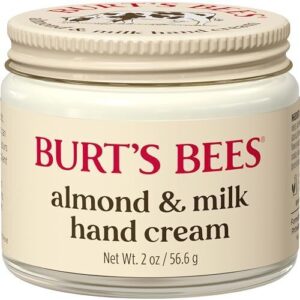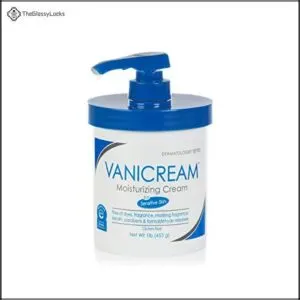This site is supported by our readers. We may earn a commission, at no cost to you, if you purchase through links.
When your skin decides to stage a rebellion with dry, flaky patches, you don’t need a chemistry degree to fight back. Olive oil, honey, and oatmeal aren’t just pantry staples—they’re backed by solid research showing they can repair damaged tissue, lock in hydration, and restore your skin’s protective barrier.
While drugstore shelves overflow with products promising miracles in a bottle, understanding which natural ingredients actually work and why they deliver results gives you the control to build a routine that makes sense for your skin.
Whether you’re dealing with occasional rough spots or persistent dryness, the right combination of evidence-based natural remedies and smart daily habits can transform your skin’s moisture balance without the guesswork.
Table Of Contents
- Key Takeaways
- Best Natural Ingredients for Dry Patches
- Home Remedies to Soothe Dry Skin
- Preventing Dry Patches Naturally
- Top 8 Products With Natural Ingredients
- 1. CeraVe Hydrating Daily Facial Cleanser
- 2. Avène Tolerance Soothing Skin Recovery Cream
- 3. Kiehl’s Ultra Facial Repair Cream
- 4. Portable Mini Cool Mist Humidifier
- 5. Burt’s Bees Almond Milk Hand Cream
- 6. La Roche-Posay Cleansing Oil for Dry Skin
- 7. Aveeno Daily Moisturizing Body Wash Oat
- 8. Vanicream Moisturizing Skin Cream With Pump
- Tips for a Natural Skin Care Routine
- Frequently Asked Questions (FAQs)
- Conclusion
Key Takeaways
- Natural ingredients like olive oil, honey, oatmeal, and jojoba oil aren’t just folk remedies—they’re backed by clinical studies showing measurable improvements in skin hydration, barrier repair, and inflammation reduction within two to four weeks of consistent use.
- The most effective approach combines immediate post-shower moisturizing (within 3-5 minutes while skin is damp), lukewarm water instead of hot showers, and targeted application of ingredients that match your specific skin needs rather than generic “natural is better” thinking.
- Products containing ceramides, colloidal oatmeal, or specific fatty acid profiles (like sunflower oil’s 60% linoleic acid) outperform many homemade remedies because they deliver controlled concentrations that clinical trials have validated for barrier function and moisture retention.
- Persistent dry patches lasting beyond six weeks despite consistent treatment may signal underlying conditions like thyroid dysfunction, nutritional deficiencies (vitamin A, zinc), or inflammatory skin diseases that require professional evaluation rather than continued self-treatment.
Best Natural Ingredients for Dry Patches
When dry patches strike, your kitchen or medicine cabinet might already hold the solution. Natural ingredients can offer real relief by locking in moisture, repairing your skin’s protective barrier, and calming irritation without harsh chemicals.
Here’s a look at seven proven options that actually work.
Olive Oil – Antioxidants and Skin Repair
When you apply olive oil to dry skin patches, you’re harnessing phenolic antioxidants that protect and repair damaged tissue. EVOO hydration boosts moisture retention while supporting wound healing through enhanced fibroblast activity. Studies show improved skin elasticity and reduced inflammation with regular use.
Olive oil is also known to moisturize and nourish the skin effectively.
However, safety concerns exist—some people experience mild irritation, so patch-test first before incorporating this natural ingredient into your routine.
Avocado – Vitamins and Probiotics
Avocado vitamins—C, E, and B3—team up with omega-3 fatty acids to lock in skin hydration and strengthen your barrier against moisture loss. Clinical findings show that fermented avocado skin extract, enhanced through probiotic fermentation, delivers potent anti-inflammatory action while boosting collagen.
Avocado also contains antioxidants that help reduce damage from external factors. For dry patches, you can mash fresh avocado into a simple mask that aids skin care with measurable hydration improvements.
Coconut Oil – Deep Moisturization
Coconut oil stands out for dry skin patches because of its unique fatty acid profile—49% lauric acid delivers antimicrobial efficacy that protects your skin microbiome while moisturizing deeply.
Clinical trials demonstrate a 36.97% TEWL reduction after four weeks, and it outperforms mineral oil in treating atopic dermatitis.
You’ll notice softer skin within days as these home remedies lock in hydration and support barrier repair through proven skin care mechanisms.
Jojoba and Argan Oil – Barrier Support
Jojoba oil mimics human sebum—its 98% wax ester composition penetrates fast without clogging pores, reducing TEWL by up to 30% within weeks.
Argan oil delivers unsaturated fatty acids and antioxidants that strengthen the skin barrier, increasing hydration and elasticity after regular use.
Both natural oils rebuild your stratum corneum, making them clinically proven allies for dry skin patches and long-term moisturizing skin health.
Honey – Emollient and Humectant Benefits
Honey benefits dry skin patches through a double action: as an emollient, it softens your rough skin, while as a humectant, it draws water into your outer skin layers for water retention.
Clinical trials show honey-infused creams boosted moisturizing skin by nearly 30% after four weeks, improving skin softening and reducing skin irritation—including dermatitis treatment and wound healing.
Aloe Vera – Soothing and Healing
Aloe vera calms inflamed dry skin patches and accelerates healing through anti-inflammatory properties that reduce redness and irritation. Clinical trials showed aloe hydration boosted skin moisture by over 40% within two weeks while strengthening the skin barrier and lowering water loss.
Tolerability studies confirm it’s safe for home remedies, with wound healing benefits surpassing standard treatments—making aloe vera a proven choice for soothing dry skin.
Oatmeal – Calming and Hydrating
Oatmeal benefits dry skin patches through colloidal properties that lock in moisture and rebuild the damaged barrier. Clinical studies show it reduces water loss while easing itch relief within weeks.
Its anti-inflammatory properties calm redness, and gentle exfoliation improves skin texture without irritation.
Try an oatmeal bath or apply colloidal oatmeal creams as effective home remedies for barrier repair.
Home Remedies to Soothe Dry Skin
You don’t always need expensive products to tackle dry skin—your kitchen probably holds some of the best solutions.
Simple home remedies can provide immediate relief while supporting your skin’s natural healing process.
Here are five tried-and-tested approaches that dermatologists often recommend to their patients.
Oatmeal Baths for Relief
When dry skin patches flare, oatmeal baths offer a clinically backed home remedy you can trust. Colloidal oatmeal reduces scaling, itching, and irritation by forming a protective film that locks in moisture and calms inflammation.
Studies show twice-daily use improves eczema severity within weeks, with low safety concerns reported across all age groups. For best results, soak 10–20 minutes, then gently pat your skin dry.
Applying Milk for Hydration
Milk composition includes lactic acid, proteins, and fatty acids that support skin hydration and gentle exfoliation. You can apply whole milk directly to dry skin patches or soak in milk baths to improve moisture retention.
While studies show protein absorption and reduced water loss, safety concerns exist for those with dairy allergies—patch test first. Home remedies like this won’t replace prescription treatments for severe skin irritation.
DIY Honey Masks for Softness
Honey’s natural humectants draw moisture into your skin, increasing hydration by an average of 18% within hours of application. You’ll want to patch test first, since about 3% of people experience mild reactions, but most tolerate raw honey well.
Studies show honey masks reduce transepidermal water loss by 23.5% over two weeks, while antimicrobial properties decrease bacteria by 68–88%. That’s significant for compromised skin that’s prone to irritation or infection.
Here’s how to create an effective honey mask at home:
- Apply 2–10% raw or Manuka honey directly to clean, dry patches for 15–20 minutes
- Combine honey with oatmeal or fruit enzymes to boost gentle exfoliation and smoothness by 34%
- Rinse with warm water and pat dry to lock in moisture without disrupting your skin barrier
Using Sunflower Seed Oil
Sunflower seed oil is a standout among natural oils for treating dry skin patches, thanks to its 60% linoleic acid content, which directly repairs the skin’s barrier function. Studies on patients with atopic dermatitis have shown an 18% improvement in hydration after four weeks, while neonatal studies confirm a 41% reduction in complications.
Here’s what makes sunflower seed oil effective:
| Benefit | Clinical Evidence |
|---|---|
| Hydration boost | 18% increase in four weeks |
| Barrier repair | Reduces water loss greatly |
| Safety profile | Non-irritating, all skin types |
| Anti-inflammatory | Aids compromised skin healing |
Apply sunflower seed oil twice daily to problem areas for measurable moisture retention without clogging pores.
Homemade Aloe Vera Gel Applications
Aloe vera stands out as another powerful remedy for dry skin patches, thanks to its anti-inflammatory properties and ability to speed healing. You can extract fresh gel from plant leaves and apply it to irritated areas two to three times daily for up to two weeks.
Here’s how to make effective DIY aloe gel at home:
- Blend 1/4 cup fresh aloe pulp with 1 tablespoon coconut oil for enhanced moisturization
- Add optional vitamin E to extend shelf life up to seven days when refrigerated
- Apply to affected areas and leave on for 5–10 minutes before rinsing to avoid dryness
- Patch test first, as 1–6% of users may experience mild skin irritation
- Store without preservatives for no more than seven days to prevent contamination
Clinical studies show aloe’s healing efficacy is impressive—chronic wounds treated with aloe gel healed 54% faster than with standard treatments. The gel’s composition includes 99% water plus glucomannan, which stimulates collagen synthesis and improves skin flexibility.
While DIY aloe gel safety is generally excellent for short-term use under 42 days, it’s worth noting that commercial moisturizers containing ceramides often outperform homemade aloe in sustained hydration after six to eight weeks. That said, aloe remains cost-effective at under $0.50 per 50 ml batch and causes less contact sensitivity than many synthetic options.
Preventing Dry Patches Naturally
Preventing dry patches isn’t just about what you put on your skin—it’s about what you do before, during, and after cleansing. Small changes to your daily routine can make a significant difference in maintaining your skin’s natural moisture barrier.
Here are four practical habits that can help you avoid dryness before it starts.
Adjusting Water Temperature
One of the simplest ways to prevent dry patches is switching from hot showers to lukewarm water. Hot water strips your skin’s natural oils, leading to barrier disruption and increased irritation. Studies show that temperatures above 107°F can more than double moisture loss, while optimal cleansing occurs between 98°F and 100°F.
| Water Temperature | Impact on Skin |
|---|---|
| Above 110°F (43°C) | Strips oils, causes inflammation, worsens dry skin |
| 98°F–100°F (37°C–38°C) | Preserves barrier, minimizes irritation, effective cleansing |
| Below 98°F (37°C) | Less drying but may not remove impurities effectively |
| Environmental conditions | Cold weather increases need for lukewarm benefits |
Temperature settings matter more than you might think—switching to lukewarm water benefits your skin barrier immediately, reducing the need for extra moisturizers by nearly 20%.
Limiting Bath and Shower Duration
Beyond water temperature, how long you stay in the shower matters just as much. Dermatologists recommend keeping baths and showers between five and ten minutes to protect your skin barrier.
Prolonged exposure—even with lukewarm water—increases transepidermal water loss by up to 25%. Short showers preserve natural oils, reduce dryness by 30%, and set the stage for effective post-shower moisturization that locks in skin hydration.
Patting Skin Dry Instead of Rubbing
After stepping out of the shower, the way you dry matters for barrier integrity. About 75% of dermatologists recommend gentle drying over vigorous towel rubbing to support TEWL reduction and preserve skin hydration. Here’s why patting works better for dry skin:
- Minimizes friction that strips natural oils
- Leaves skin slightly damp for best product absorption
- Reduces mechanical irritation and microtears
- Protects compromised barriers in sensitive skin
Gentle drying is a simple home remedy that directly impacts skin health.
Moisturizing Immediately After Washing
When you lock in hydration right after patting dry, you’re giving your skin’s barrier function a real advantage. Clinical outcomes show that post-wash timing matters: moisturizing skin while it’s slightly damp boosts TEWL reduction and heightens skin hydration. This simple step in your skincare routine after bathing helps ingredients for dry skin penetrate better, supporting practical parameters that dermatologists measure in studies.
| Application Window | Stratum Corneum Hydration | Barrier Benefit |
|---|---|---|
| Within 3–5 minutes | Considerably higher | Maximum protection |
| After 30 minutes | Moderate improvement | Reduced effectiveness |
| After 90 minutes | Minimal difference | Limited seal-in |
| No moisturizer | Post-wash dryness observed | Barrier disruption |
Skincare products with hyaluronic acid, glycerin, or natural oils work best when applied to damp skin, sealing in moisture before it evaporates.
Top 8 Products With Natural Ingredients
You don’t have to make your own remedies from scratch to benefit from natural ingredients. Many trusted skincare brands now formulate products with plant-based oils, oatmeal, aloe, and other gentle ingredients that support your skin’s barrier.
Here are eight products that combine natural moisturizers with proven effectiveness for dry patches.
1. CeraVe Hydrating Daily Facial Cleanser
If you’re dealing with stubborn dry skin patches, CeraVe Hydrating Daily Facial Cleanser offers a solution grounded in solid dermatologist recommendations. This formulation combines three essential ceramides with hyaluronic acid and glycerin, ingredients proven to restore your skin’s barrier while delivering 24-hour hydration efficacy.
It’s fragrance-free and non-comedogenic, making it ideal for sensitive skin.
Clinical studies show that ceramide benefits include improved barrier function and reduced irritation, with users experiencing noticeable relief from dry patches within just one week of consistent use.
Best For: People with dry, sensitive, or eczema-prone skin who need a gentle cleanser that hydrates while removing dirt and makeup without stripping the skin’s natural moisture barrier.
- Contains three essential ceramides plus hyaluronic acid that clinically improve skin hydration within 7 days and help repair your skin’s protective barrier
- Fragrance-free and non-comedogenic formula is certified by the National Eczema Association, making it safe for sensitive and reactive skin types
- Uses MVE technology to release moisturizing ingredients over time, providing 24-hour hydration that lasts well after you rinse
- May not be strong enough to remove heavy makeup or thick sunscreen in one wash—some people need to double cleanse
- Not ideal for oily skin types who might prefer a foaming cleanser that feels more “clean”
- A few users reported inconsistent product quality or receiving damaged items
2. Avène Tolerance Soothing Skin Recovery Cream
When your skin reacts to nearly everything, Avène Tolerance Soothing Skin Recovery Cream acts like a reset button for hypersensitive dry skin. This sterile formula features 98% natural ingredients, including postbiotic innovation that clinical studies show achieved 98.5% tolerability ratings among dermatologist assessments.
You’ll notice immediate relief—88.3% of users reported symptom improvement after just one application. The combination of D-Sensinose and Avène Thermal Spring Water delivers 24-hour hydration efficacy while treating dry skin patches without preservatives or fragrances, making it essential for sensitive skin care routines.
Best For: People with hypersensitive, reactive, or allergy-prone skin who need fast relief from burning, tingling, and tightness without risking irritation from common skincare ingredients.
- Clinically proven to calm skin in 30 seconds and restore the skin barrier within 48 hours, with 98.5% dermatologist-rated tolerability
- 100% sterile, preservative-free, and fragrance-free formula with 98% natural ingredients minimizes allergic reactions even on the most reactive skin
- Provides 24-hour hydration that’s thick and nourishing but absorbs without greasiness, working well under makeup or overnight
- May not deliver enough moisture for extremely dry or dehydrated skin that needs heavy-duty repair
- Higher price point compared to standard drugstore moisturizers, which might not fit every budget
- Limited availability in some areas and may require ordering online or visiting specialty retailers
3. Kiehl’s Ultra Facial Repair Cream
When your barrier repair needs go beyond basic moisturization, Kiehl’s Ultra Facial Enhanced Repair Barrier Cream delivers measurable hydration performance within one hour. Clinical testing on 28 subjects with tape-stripped skin demonstrated temporary barrier restoration, while the formula increased hydration by 132% and maintained it for up to 72 hours.
The combination of colloidal oatmeal and beta-glucan works to moisturize skin while supporting redness reduction tied to dryness. Its National Eczema Association acceptance confirms it’s among the most trusted skin care products for compromised barriers and dry skin patches.
Best For: People with sensitive, eczema-prone, or very dry skin who need targeted barrier repair and fast-acting redness relief in problem areas.
- Clinically proven to restore moisture barrier function within an hour and boost hydration by 132% with effects lasting up to 72 hours
- Contains colloidal oatmeal and beta-glucan to soothe irritation and reduce visible redness tied to dryness
- Earned the National Eczema Association Seal of Acceptance, confirming it’s safe and effective for compromised skin
- Pricey for a small 1.7 oz tube, which can add up if you’re using it daily on larger areas
- Some users report a slightly tacky feel after application that may not absorb as quickly as lighter creams
- Benefits may fade without consistent use, so you’ll need to keep reapplying to maintain results
4. Portable Mini Cool Mist Humidifier
When indoor air feels like sandpaper against your face, a portable mini cool mist humidifier can become your dry skin’s closest ally. These compact devices add measurable moisture to your environment, helping relieve the tightness and flaking that plague many patients during heating season.
Unlike warm mist models, cool mist safety makes them ideal for bedrooms and offices. They consume less energy (about 11.8 KWh annually) and require simple maintenance—just regular cleaning and filter changes every one to two months to prevent bacterial growth.
Best For: People dealing with dry skin, chapped lips, or respiratory discomfort who need an affordable, energy-efficient solution for small spaces like bedrooms, offices, or cars.
- Uses minimal energy compared to warm mist models, running on just 11.8 KWh per year while still effectively adding moisture to dry indoor air.
- Safer around kids and pets since there’s no hot water or steam involved, plus most models include auto shut-off features.
- Compact and portable design makes it easy to move between rooms or take along when traveling.
- Small 300ml tank means you’ll need to refill it multiple times throughout the day for continuous use.
- Requires consistent cleaning every 1-2 months to prevent mold and bacteria buildup in the water tank.
- Some units have reliability issues, with users reporting the device stops working or the light feature won’t turn off after several weeks of use.
5. Burt’s Bees Almond Milk Hand Cream
For hands that crack and bleed from constant washing, Burt’s Bees Almond Milk Hand Cream offers a 99.9% natural solution backed by real user experiences. Its blend of sweet almond oil benefits—rich vitamin E content—and beeswax composition creates a protective barrier that locks in moisture for up to 24 hours.
The nutty scent profile appeals to most, though it’s distinctly recognizable. While the thick texture requires patience to absorb, reviewers praise its overnight effectiveness on severe dry skin patches.
Note: it contains beeswax, so you’ll need vegan alternatives if that’s a concern.
Best For: People with severely dry, cracked, or hard-working hands who need intense, long-lasting moisture and don’t mind a thick, rich texture that takes a minute to absorb.
- 99.9% natural ingredients with sweet almond oil, beeswax, and vitamin E that hydrate for up to 24 hours
- Works exceptionally well as an overnight treatment for cracked or bleeding hands from frequent washing
- Multi-purpose formula that also softens rough elbows, knees, feet, and cuticles
- Thick, buttery texture feels greasy and requires a couple minutes to fully absorb into skin
- Contains tree nut ingredients (almond oil) and beeswax, making it unsuitable for people with nut allergies or vegans
- Strong almond scent may be too intense for those sensitive to fragrances
6. La Roche-Posay Cleansing Oil for Dry Skin
While hand creams tackle localized dryness, you’ll need something gentler for larger dry skin patches on your face and body.
La Roche-Posay’s Cleansing Oil delivers clinical-grade hydration without stripping your natural barrier—dermatologist recommendations back this up. Its niacinamide-enriched formula provides 24-hour moisture retention, a claim supported by user satisfaction reviews showing consistent relief from flakiness.
Key ingredients analysis reveals thermal spring water and shea butter working alongside coconut oil derivatives. Market position analysis confirms it’s National Eczema Association-accepted, making it a home remedy upgrade worth considering.
Best For: People with dry to extra dry, sensitive, or eczema-prone skin who need a gentle cleanser that hydrates while removing dirt without stripping the skin barrier.
- Provides 24-hour hydration with niacinamide and thermal spring water, clinically proven to relieve flakiness and tightness
- Safe for sensitive skin, babies as young as 2 weeks, and chemotherapy patients—fragrance-free, soap-free, and dermatologist-tested
- Works on both face and body with high user ratings (4.5/5) and National Eczema Association acceptance
- Can sting if it gets in your eyes during use
- May not effectively remove heavy makeup, requiring a second cleanse
- Lightweight gel-like texture might feel too thin for some users expecting a richer oil consistency
7. Aveeno Daily Moisturizing Body Wash Oat
If you’re looking for a body wash that won’t strip your skin dry, Aveeno’s oat formula delivers what clinical studies confirm: 92% user satisfaction for nourished skin.
Over 30 trials show prebiotic oat improves skin hydration by supporting your natural moisture barrier—that’s the science behind why oatmeal for skin works.
It’s free from parabens and dyes, making it safe for sensitive skin and even eczema-prone patches. You’ll notice less dryness after consistent use, a genuine home remedy upgrade in bottle form.
Best For: People with dry or sensitive skin who want a gentle, clinically-backed body wash that actually hydrates instead of stripping natural oils.
- Prebiotic oat formula is backed by over 30 clinical studies showing real improvements in skin hydration and moisture retention
- Free from parabens, dyes, sulfates, and soap, making it safe for sensitive skin and even eczema-prone areas
- 92% of users report feeling nourished after use, with many seeing up to 44% less dryness after four weeks
- Doesn’t lather as much as traditional body washes, so you might need to use more product per shower
- The light scent may disappoint if you prefer a stronger, more noticeable fragrance
- Large 18oz bottle can feel heavy and awkward to handle, especially with wet hands
8. Vanicream Moisturizing Skin Cream With Pump
While oat-based washes help during cleansing, Vanicream Moisturizing Skin Cream addresses dry skin patches after you dry off. Dermatologist recommended and holding the National Eczema Association Seal, it’s formulated for sensitive skin without fragrances, dyes, or parabens—common irritants that worsen home remedies.
Petrolatum creates a barrier that reduces water loss by up to 98%, while humectants like sorbitol boost skin hydration. Non-comedogenic benefits mean it won’t clog pores, and consumer acceptance remains high—over 90% report improved skin moisture.
The pump dispenser keeps things hygienic, encouraging consistent use.
Best For: People with sensitive skin, eczema, or psoriasis who need a fragrance-free, hypoallergenic moisturizer that won’t clog pores or irritate already-dry skin.
- Clinically proven barrier protection—petrolatum cuts water loss by up to 98%, and regular use improves moisture retention by over 30% in two weeks.
- Free of common irritants like fragrances, dyes, parabens, and lanolin, making it safe for people prone to contact dermatitis or allergic reactions.
- Holds the National Eczema Association Seal and is dermatologist recommended, with over 90% of users reporting real improvement in dryness and irritation.
- Thick texture takes effort to rub in, and some users find it too greasy or heavy for daily wear under makeup.
- Pump dispenser can dry up or leave product stuck at the bottom, making it hard to use every last bit.
- One animal study showed a 58% increase in tumor count compared to controls, though it didn’t increase the proportion of tumor-bearing subjects—something to discuss with your doctor if you’re concerned.
Tips for a Natural Skin Care Routine
Building a natural skin care routine doesn’t have to be complicated, but it does require consistency and attention to what works for your skin. The key is layering proven ingredients and practices in a way that bolsters your skin barrier without overwhelming it.
Here are five practical tips to help you create a routine that keeps dry patches at bay while maintaining healthy, hydrated skin.
Incorporating Natural Oils Into Daily Care
Think of your skin care routine as building a foundation—natural oils for skin are the cornerstone. Start with oil cleansing to dissolve impurities without stripping moisture.
Layering oils like jojoba or almond after damp skin locks in hydration effectively. For targeted application, mix a few drops with your moisturizer or apply carrier oils directly to dry patches during your nighttime routine for best barrier repair.
Gentle Exfoliation With Fruit Enzymes
When dead skin cells build up over dry patches, fruit enzymes like papain from papaya or bromelain from pineapple dissolve them gently. Unlike harsher acids, these enzymes target only surface proteins, making them safer for sensitive skin types.
Apply an enzyme peel once or twice weekly, checking enzyme concentration levels and watching for reactions. This controlled exfoliation improves skin texture without compromising your barrier.
Hydrating Diet for Skin Health
What you eat shapes your skin’s moisture balance just as powerfully as what you apply topically. A healthy skin diet built around these elements makes a measurable difference:
- Omega-3 fatty acids from fish oil reduce dryness and strengthen your barrier—fish oil supplementation increased skin omega-3s by 1.6-fold in 90 days
- Water intake around 2 liters daily improves hydration in both superficial and deep skin layers
- Antioxidant photoprotection through Mediterranean-style eating lowers inflammation
Ceramide supplements, lower glycemic load carbohydrates, and addressing nutritional deficiencies complete your internal strategy for healthy skin.
Protecting Skin From Environmental Stressors
Pollution skin damage and UV light protection aren’t optional—these environmental factors drive up to 80% of visible aging.
You can fight back with natural oil defense strategies: apply antioxidant-rich plant oils like argan to neutralize free radicals, reducing cellular damage by over 40%. Broad-spectrum mineral sunscreen blocks 98% of harmful rays.
In cold weather, layering humectant moisturizers creates routine stress mitigation that restores barrier function and prevents dry patches from environmental irritants.
Recognizing and Treating Underlying Skin Conditions
Persistent dry patches may signal conditions beyond simple dehydration—nutritional deficiencies (vitamin A in 25% of xerosis cases, zinc in 40% of dermatitis), endocrine disorders like hypothyroidism (67% show dry skin), metabolic disease including diabetes, inflammatory dermatoses such as atopic dermatitis, or contact dermatitis warrant evaluation. If home remedies fail after six weeks, consult a dermatologist to identify underlying skin conditions and access targeted treatments with anti-inflammatory properties.
- Check thyroid function when xerosis accompanies fatigue
- Test for vitamin A and zinc deficiencies
- Consider patch testing for persistent localized patches
- Evaluate diabetes risk with chronic lower-leg dryness
Frequently Asked Questions (FAQs)
How long do natural remedies take to work?
Most natural remedies show noticeable improvement within two to four weeks of consistent application. Severity affects speed—mild dryness responds faster than chronic cases.
Realistic expectations matter, as ingredient absorption rates vary and home remedies require patience for meaningful skin hydration.
Which natural oils work best for sensitive skin?
Jojoba, sunflower, and argan oils offer excellent oil benefits for sensitive skin, supporting the skin barrier with anti-inflammatory skin treatments.
They reduce irritation, improve hydration, and have low comedogenic ratings, making them ideal for natural skin care.
Are there side effects from using natural moisturizers?
Over 94% of products marketed as “natural” contain known contact allergens, challenging the assumption that plant-based moisturizers are inherently safer.
Allergic reactions, comedogenic oils, barrier disruption, and photosensitivity risk remain significant concerns dermatologists encounter daily.
Can you combine multiple natural ingredients safely together?
You can safely combine natural remedies like honey with avocado oil or mix humectants such as glycerin with jojoba oil.
However, always patch test first to avoid skin sensitizers and respect dilution standards.
Conclusion
Your bathroom cabinet doesn’t need to look like a research laboratory to deliver results. Natural ingredients for dry patches work when you match the science to your skin’s needs—whether that’s honey’s humectant pull, oatmeal’s barrier repair, or jojoba oil’s biomimicry.
The difference between guesswork and genuine improvement lies in understanding what each ingredient actually does, then building a routine that lets your skin do what it already knows how to do: heal itself.
- https://skin.dermsquared.com/skin/article/view/351
- https://pmc.ncbi.nlm.nih.gov/articles/PMC10794395/
- https://www.medicalnewstoday.com/articles/319555
- https://onlinelibrary.wiley.com/doi/10.1111/jocd.16710
- https://www.laroche-posay.us/skincare-tips-and-advice/eczema-dry-skin/7-ingredients-for-dry-skin.html



